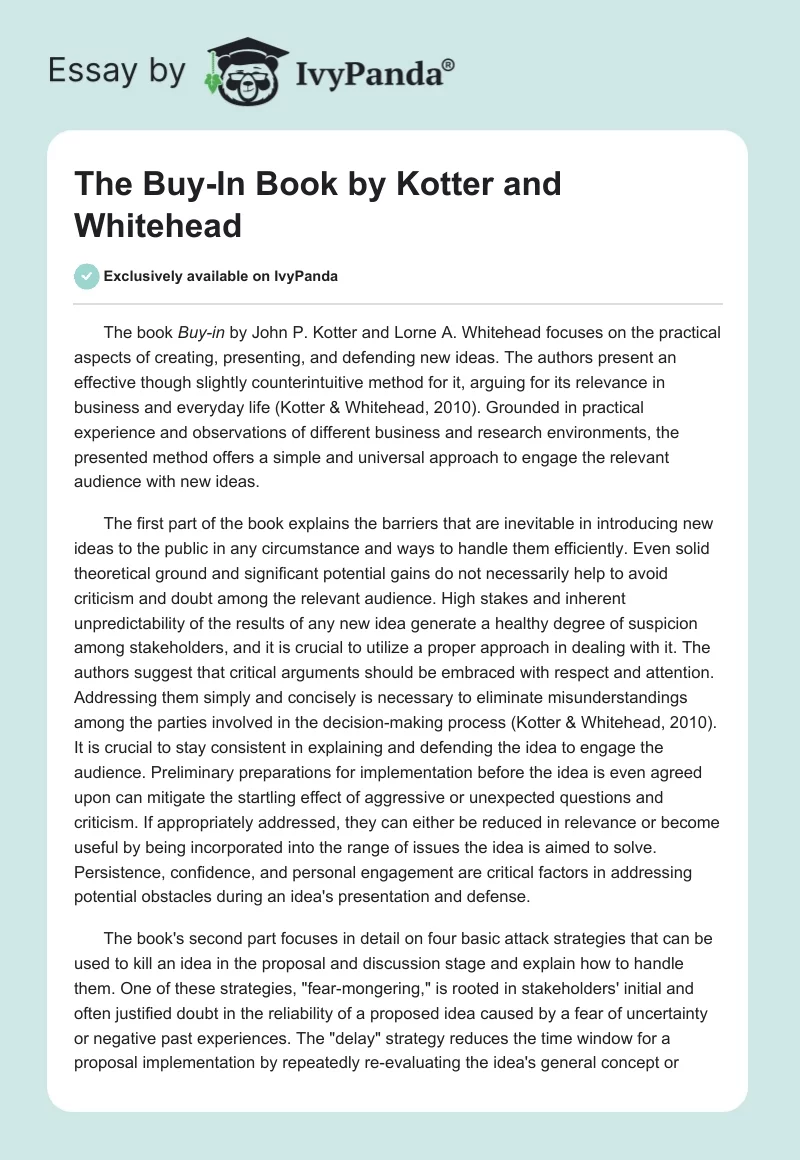The book Buy-in by John P. Kotter and Lorne A. Whitehead focuses on the practical aspects of creating, presenting, and defending new ideas. The authors present an effective though slightly counterintuitive method for it, arguing for its relevance in business and everyday life (Kotter & Whitehead, 2010). Grounded in practical experience and observations of different business and research environments, the presented method offers a simple and universal approach to engage the relevant audience with new ideas.
The first part of the book explains the barriers that are inevitable in introducing new ideas to the public in any circumstance and ways to handle them efficiently. Even solid theoretical ground and significant potential gains do not necessarily help to avoid criticism and doubt among the relevant audience. High stakes and inherent unpredictability of the results of any new idea generate a healthy degree of suspicion among stakeholders, and it is crucial to utilize a proper approach in dealing with it. The authors suggest that critical arguments should be embraced with respect and attention. Addressing them simply and concisely is necessary to eliminate misunderstandings among the parties involved in the decision-making process (Kotter & Whitehead, 2010). It is crucial to stay consistent in explaining and defending the idea to engage the audience. Preliminary preparations for implementation before the idea is even agreed upon can mitigate the startling effect of aggressive or unexpected questions and criticism. If appropriately addressed, they can either be reduced in relevance or become useful by being incorporated into the range of issues the idea is aimed to solve. Persistence, confidence, and personal engagement are critical factors in addressing potential obstacles during an idea’s presentation and defense.
The book’s second part focuses in detail on four basic attack strategies that can be used to kill an idea in the proposal and discussion stage and explain how to handle them. One of these strategies, “fear-mongering,” is rooted in stakeholders’ initial and often justified doubt in the reliability of a proposed idea caused by a fear of uncertainty or negative past experiences. The “delay” strategy reduces the time window for a proposal implementation by repeatedly re-evaluating the idea’s general concept or specific points, putting off the implementation, or switching attention to alternative ideas. The “confusion” strategy lies in flooding the conversation with irrelevant facts and questions that shift the audience’s attention away from the topic. The “ridicule” strategy is primarily directed at the proposal’s author by undermining their authority, questioning their competence, and reducing their confidence.
The authors propose three steps to mitigate the harmful effects of the attacks. Capturing and holding the audience’s attention from the beginning of a presentation is vital to generate useful discussion and prevent people from being distracted. It is essential to include all parties in the discussion since addressing any potential criticism at the initial stage can turn the critics to the accepting side and prevent more significant crises in the future. The relevant and attentive audience’s engagement is reached by presenting the arguments clearly and concisely without overwhelming them with excessive information and complex concepts. Proper preparation also helps build the author’s self-confidence and present themselves as competent and knowledgeable. By combining clear presentation and professional confidence, the author can appeal to the audience’s emotions more easily to engage them on a deeper level. Showing respect and interest in people’s anxieties help build a more personal connection between the audience and the author, which can be directed to the proposed idea. Adequate answers to the attack questions often lie in the questions themselves; reversing the negative arguments can generate additional and unexpected points for the idea.
References
Kotter, J. P., & Whitehead, L. A. (2010). Buy-in. Harvard Business review Press.


